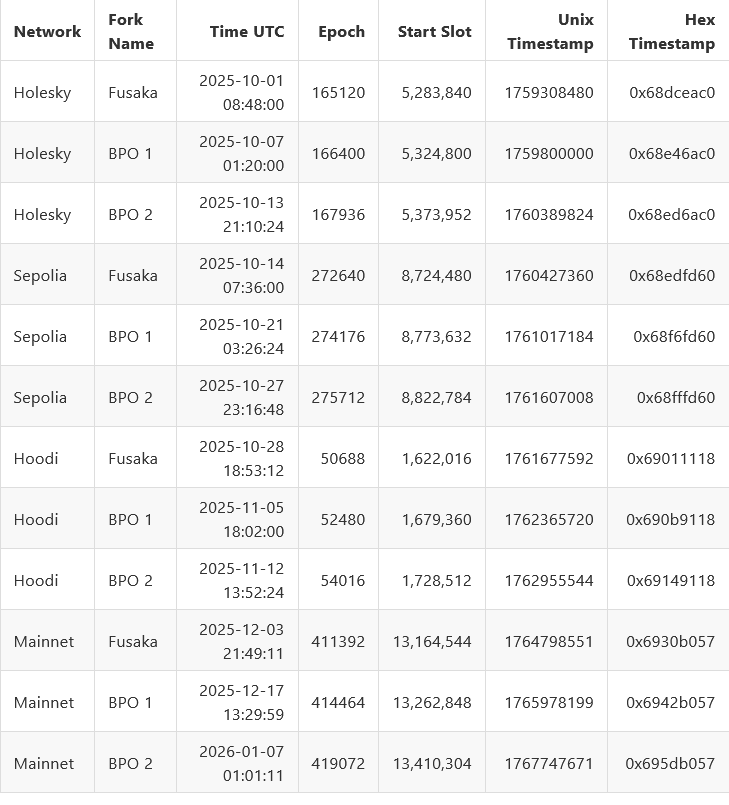The Fusaka hard fork is scheduled for Dec. 3 and will deliver 12 EIPs to increase Ethereum’s blob capacity, improve scalability and reduce transaction costs; two subsequent blob-capacity BPO forks are planned for Dec. 17 and Jan. 7, 2026 to more than double blob limits.
-
Fusaka hard fork launches on Dec. 3 with 12 EIPs to improve scalability and cost-efficiency.
-
Blob capacity increases follow on Dec. 17 and Jan. 7, 2026, with planned BPOs to raise max blob counts.
-
Security and testing: three public testnets plus a $2M Ethereum Foundation audit program to find vulnerabilities.
Meta description: Fusaka hard fork on Ethereum set for Dec. 3 to boost blob capacity, improve scalability and reduce costs — read timeline and key takeaways.
What is the Fusaka hard fork?
Fusaka hard fork is Ethereum’s planned protocol upgrade set for Dec. 3 that introduces 12 Ethereum Improvement Proposals (EIPs) to enhance scalability, security and cost efficiency. The upgrade includes subsequent blob-parameter-only (BPO) hard forks to increase offchain blob capacity for layer-2 throughput.
How will Fusaka increase blob capacity and reduce transaction costs?
Fusaka includes multiple BPO forks that adjust blob targets and limits without requiring client-side updates. The initial deployment is Dec. 3, with blob capacity increases activated around Dec. 17 and a further BPO on Jan. 7, 2026. Ethereum researchers report proposed max blob counts of 15 for BPO1 and 21 for BPO2, which would more than double current capacities.

Blobs store large offchain data sets used by layer-2 rollups, which reduces calldata pressure on mainnet and lowers transaction costs. Blob usage has risen steadily since the Dencun upgrade: average blob count per block is about 5.1 now versus 0.9 in March 2023, based on public Dune analytics.
The Ethereum developer community has planned five BPO forks across Fusaka to ensure safer, scalable increases in mainnet capacity. ethPandaOps communicated proposed max blob counts publicly, while Ethereum researcher Christine D. Kim summarized expected capacity timelines.
When will public testing and security audits complete before mainnet?
Three public testnets are scheduled between early October and mid-November to validate Fusaka changes. The Ethereum Foundation announced a four-week code-audit program offering $2 million in bounties to researchers who responsibly disclose vulnerabilities in the Fusaka codebase. These steps are intended to improve security posture prior to the Dec. 3 mainnet activation.
Why do blob-parameter-only (BPO) forks matter?
BPO forks change only blob-related parameters — targets and limits — and do not require client software updates. This design allows quicker, lower-risk capacity scaling and gives the network flexibility to meet growing layer-2 demand without broad client rollouts.
What are the network health and staking implications around Fusaka?
Separately, Ethereum’s exit queue recently hit a record 2.6 million ETH (roughly $12 billion) entering the queue, which raised community discussion on exit limits. Current wait times in the exit queue are about 43 days. Vitalik Buterin has defended the exit queue length as a trust and security mechanism; others have expressed concerns about potential selling pressure from large unstaking flows.
Frequently Asked Questions
When will the blob capacity increases take effect?
The main Fusaka fork is scheduled for Dec. 3. The first blob capacity increase is expected around Dec. 17, with an additional blob-capacity BPO planned for Jan. 7, 2026.
Will node operators need to upgrade clients for Fusaka?
BPO forks that adjust blob parameters do not require client-side updates. Node operators should still monitor client release notes and join testnets to confirm compatibility.
Key Takeaways
- Fusaka launch date: Dec. 3 with 12 EIPs to boost scalability and efficiency.
- Blob capacity increases: Additional BPO forks on Dec. 17 and Jan. 7, 2026 aim to more than double capacity.
- Security and testing: Three public testnets and a $2M audit program protect mainnet readiness.
Conclusion
The Fusaka hard fork marks a targeted effort to scale Ethereum through controlled blob-parameter increases and a package of 12 EIPs. With staged BPO forks, public testnets and a dedicated audit program, Fusaka seeks to raise layer-2 throughput while preserving network safety. Monitor testnets and official announcements from Ethereum developer channels and COINOTAG for updates.
